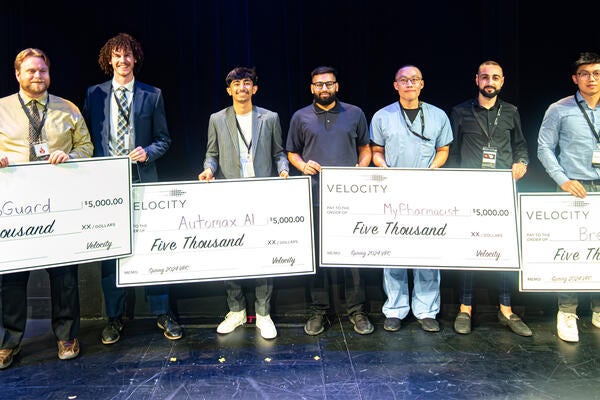
First image of black hole captured
A historic global collaboration, with contributions by a Waterloo physicist, has lifted the veil on a cosmic mystery by proving the existence of black holes.

A historic global collaboration, with contributions by a Waterloo physicist, has lifted the veil on a cosmic mystery by proving the existence of black holes.
By Media Relations
Avery Broderick, a professor at the University of Waterloo and an associate faculty member at Perimeter Institute for Theoretical Physics, and his group played a key role in helping the Event Horizon Telescope (EHT) Collaboration interpret the historic images. Broderick also previously developed theoretical models that accurately predicted what the images would look like.
“The EHT is a culmination of almost two decades of effort by a global team,” said Broderick, who also holds the Delaney Family John Archibald Wheeler Chair at Perimeter. “Once you’ve invested that sort of time, it’s a deep feeling of satisfaction that, finally, we have in hand this quarry we’ve been chasing for so long.
“This first image is beautiful and a profound moment in science – it’s the first time we’ve seen the unseeable.”
Avery Broderick (click on image to play video)
The EHT — a planet-scale array of eight ground-based radio telescopes forged through international collaboration — was designed to capture images of a black hole. Today, in coordinated press conferences across the globe, EHT researchers reveal that they have succeeded, unveiling the first direct visual evidence of a supermassive black hole and its shadow.
This breakthrough was announced today in a series of six papers published in a special issue of The Astrophysical Journal Letters. The image reveals the black hole at the centre of Messier 87, a massive galaxy in the nearby Virgo galaxy cluster. This black hole resides 55 million light-years from Earth and has a mass 6.5-billion times that of the Sun.
The EHT links telescopes around the globe to form an Earth-sized virtual telescope with unprecedented sensitivity and resolution. The EHT is the result of years of international collaboration, and offers scientists a new way to study the most extreme objects in the Universe predicted by Einstein’s general relativity during the centennial year of the historic experiment that first confirmed the theory.
Broderick, who developed the first theoretical models that correctly predicted what the EHT would see, is now working with his colleagues to exploit the observations to reveal a new understanding about how these behemoths work.
“It turns out our predictions were stunningly close; we were spot-on,” he said. “Now, we’re salivating about all the science that the EHT will allow us to do. We can now probe the gravitational regime right at the edge of the most massive type of black hole known in the universe; these incredibly massive things that lie at the centres of galaxies and rule their fates.”
Although we had a good idea that supermassive black holes (and event horizons) existed before the EHT’s first image we had only indirect evidence of their existence. This first image is undeniable proof of their existence and is a robust test of general relativity in the most extreme gravitational environment known, added Broderick. “A black hole is a gravitational feature that comes right out of Einstein’s theory of general relativity, first described over a century ago and implicated – but never proven – to exist. Until now.”
While this first image may appear to agree with Einstein’s theories and be a wonderful validation of event horizon simulations, Broderick emphasized that further investigations and more observations of other supermassive black holes may turn up some surprises.
The majority of galaxies are thought to contain supermassive black holes in their cores, including our galaxy, the Milky Way. M87’s black hole was chosen as the first black hole to be imaged as, though it is 2,000 times further away than the black hole in the centre of our galaxy (called Sagittarius A*, or Sgr A* for short), counterintuitively M87 is easier for the EHT to see.
“We had to start somewhere,” added Broderick. “M87 represents the first end-to-end exercise of the entire EHT collaboration, from data taking to data interpretation.”
Observations of Sgr A* are ongoing, and other supermassive black holes in our local universe will be identified as possible EHT candidates. The EHT will also be regularly checking back on M87 and Sgr A* to see how they change over time, as both are very dynamic and very interesting black hole targets.
“Now we have the opportunity to do all of those things that we’ve been dreaming of,” Broderick concluded. “For me, this first image represents the end of the development phase. There are so many things we’ve been hoping to investigate, and now we have a window into the universe that can help us do those things using real observational data.
“This is only the beginning of a new era of discovery.”

Read more
Velocity pitch competition winners share exciting startup ideas using artificial intelligence and deep tech, showcasing creativity and entrepreneurial prowess

Read more
Waterloo students earn more than $700,000 in grants to scale their research efforts on lab-grown fish

Read more
Modular software brings together a variety of expertise to create a new method to realistically model and analyze quantum cryptography
The University of Waterloo acknowledges that much of our work takes place on the traditional territory of the Neutral, Anishinaabeg, and Haudenosaunee peoples. Our main campus is situated on the Haldimand Tract, the land granted to the Six Nations that includes six miles on each side of the Grand River. Our active work toward reconciliation takes place across our campuses through research, learning, teaching, and community building, and is co-ordinated within the Office of Indigenous Relations.